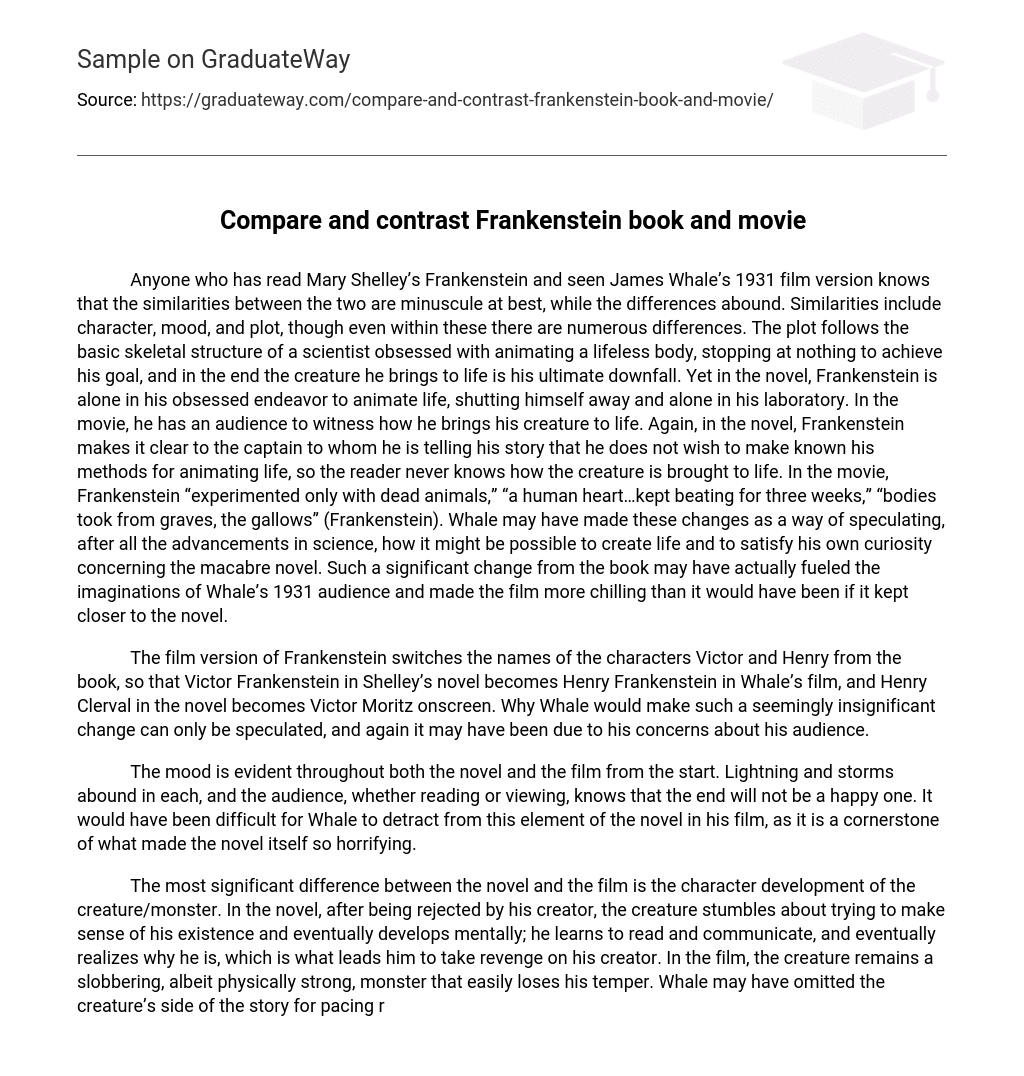Anyone who has read Mary Shelley’s Frankenstein and seen James Whale’s 1931 film version knows that the similarities between the two are minuscule at best, while the differences abound. Despite character, mood, and plot being similar in some ways, there are numerous differences even within these aspects. The plot follows a scientist obsessed with animating a lifeless body who stops at nothing to achieve his goal. In the end, the creature he brings to life is his ultimate downfall.
However, in the novel Frankenstein works alone in his endeavor to animate life and shuts himself away in his laboratory. In contrast, in the movie he has an audience witnessing how he brings his creature to life.
In addition, Frankenstein makes it clear to the captain whom he tells his story that he does not wish to make known how he animates life. Therefore readers never know how Frankenstein brought his creature to life in Shelley’s novel. Conversely, Whale’s movie depicts Frankenstein experimenting only with dead animals and using bodies taken from graves or gallows.
Whale may have made these changes as a way of speculating about how it might be possible to create life after all advancements in science or satisfying curiosity concerning Shelley’s macabre novel. Such significant changes from Shelley’s book may have fueled imaginations of Whale’s 1931 audience and made this film more chilling than if it had kept closer to its source material.
The film adaptation of Frankenstein made a change in the names of the characters. In Mary Shelley’s novel, Victor Frankenstein is the protagonist while Henry Clerval is his friend. However, in James Whale’s movie, Victor becomes Henry and Henry becomes Victor Moritz onscreen. The reason behind this alteration remains unclear and can only be speculated upon. It is possible that Whale made this change due to concerns about his audience.
The mood is evident throughout both the novel and the film from the start. Lightning and storms abound in each, and the audience, whether reading or viewing, knows that the end will not be a happy one. It would have been difficult for Whale to detract from this element of the novel in his film as it is a cornerstone of what made the novel so horrifying.
The most significant difference between the novel and the film is the character development of the creature/monster. In the novel, after being rejected by his creator, the creature stumbles about trying to make sense of his existence. Eventually, he develops mentally; he learns to read and communicate. He realizes why he is, which leads him to take revenge on his creator. In contrast, in the film, the creature remains a slobbering monster that easily loses his temper despite being physically strong.
Whale may have omitted the creature’s side of the story for pacing reasons since most of Frankenstein’s film centers around how Frankenstein brought him to life. On contrary, Mary Shelley’s novel takes a more philosophical bent on playing God by allowing readers to see both sides of this story.
James Whale’s film adaptation of Mary Shelley’s Frankenstein may have had an irrevocable influence on how subsequent generations approach the story. This has resulted in preconceived notions about how the narrative will unfold. However, I do not believe that this has harmed Shelley’s original story. Instead, it provides a delightful surprise for readers to discover the multifaceted and complex character known as the monster. It also allows them to realize that the monster may not be so much a creature but rather Frankenstein himself, the creator.
Works Cited
Frankenstein, directed by James Whale and written by Peggy Webling, John Balderston, et al., is a film produced by Universal Pictures in 1931.





